The Best Deals on Camping, Backpacking and Outdoor Gear [June 2025]
Ultralight backpacking gadgets are everywhere these days, constantly vying for your attention and begging you to spend on more innovative new gear that promises to make your time on the trail better! We love perusing pages of these items, dreaming of how we might use them all on our next adventure. But are they actually worth it? Especially for ultralight backpackers whose goal is to carry less? (For reference, we’re fairly extreme ultralighters: our base weight is often around 8.2lbs.)
We put 10 ultralight backpacking gadgets we found on Garage Grown Gear, our favorite website for all things ultralight, to the test to see which ones are actually worth the weight, and which ones are a waste of space (and why we think so). Naturally, we all hike and backpack in our own ways, and what we find valuable or useful will vary, so take each review with a grain of salt. Our goal is to help you save weight, save money, and save space in your gear closet (plus reduce the waste that results when you buy stuff that never gets used) when you inevitably fall for the hype of something tiny and cool and then realize it’s not as functional as the solution you’ve been using all along. It’s all in the name of sustainability.
Want to see the gear we DO always take ultralight backpacking? Check out our couple’s sub-10 lb ultralight kit. Then check out 5 tips for really reducing the weight of your pack.
A Note on Testing
We tested all of these mini gadgets for hikes and tried to honestly asses which ultralight backpacking gadgets are actually useful and beneficial to backpackers in general based on the core principle of ultralight backpacking that less is more. That said, we know that gear is largely based on personal preference and individual backpacking style. So you’re welcome to disagree with our assessments. In fact, if you do, leave a comment explaining why you love something we said was a flop!
Ultralight Backpacking Gadgets
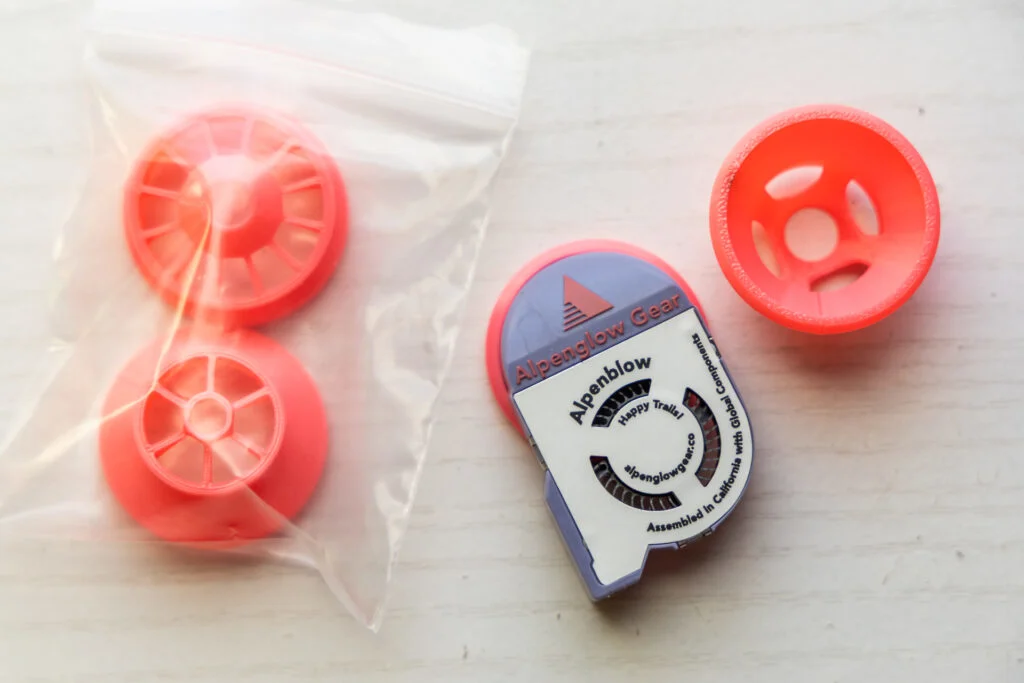
Alpenglow Gear Alpenblow Micro Inflator: Worth the Weight
Weight: 8g
One ultralight backpacking gadget we’ve considered packing for years but never have is a pad inflator. We’ve always just blown up our insulated pads with the power of our own lungs (because we haven’t committed to sleeping on a folding foam Z Rest on its own), but in my opinion, that gets old fast. In fact, inflating a sleeping pad is my absolute least favorite thing to do when setting up camp. A pump sack makes the job easier, but those can be heavy and unwieldy, not to mention they’re still fairly slow, and not all inflatable pads come with one. So why, we thought, wouldn’t we try packing something that weighs less than a pump sack and can inflate our pads FOR US while we focus on dinner?
The Alpenblow may be the lightest pad inflator on the market, which is why it caught our eye. And why it earned a place in our packs for good. You do have to have some kind of backup battery (we love the ultralight Nitecore NB Air 5000 mAh) or a phone with a USB-C port and a small C-to-C cable to operate it, but we’re already packing those anyway, so we don’t mind. The Alpenblow took about 10 minutes to inflate a mummy-shaped pad plus three more breaths to fully pump it up, but since we can go about our business making dinner while it works, that’s fine with us. UPDATE: We recently learned if you open the pad valve to “deflate” it inflates WAY faster. As for how much battery it requires, there were two out of four bars lit up on our Nitecore before we started and two after, so power draw seems negligible. It comes with four adapters that fit six different pad valves from well-known brands, plus there are additional adapters available if you have a more obscure pad. Bottom line: This device definitely earned a place in my ultralight kit.
Alternative: Use your lungs.
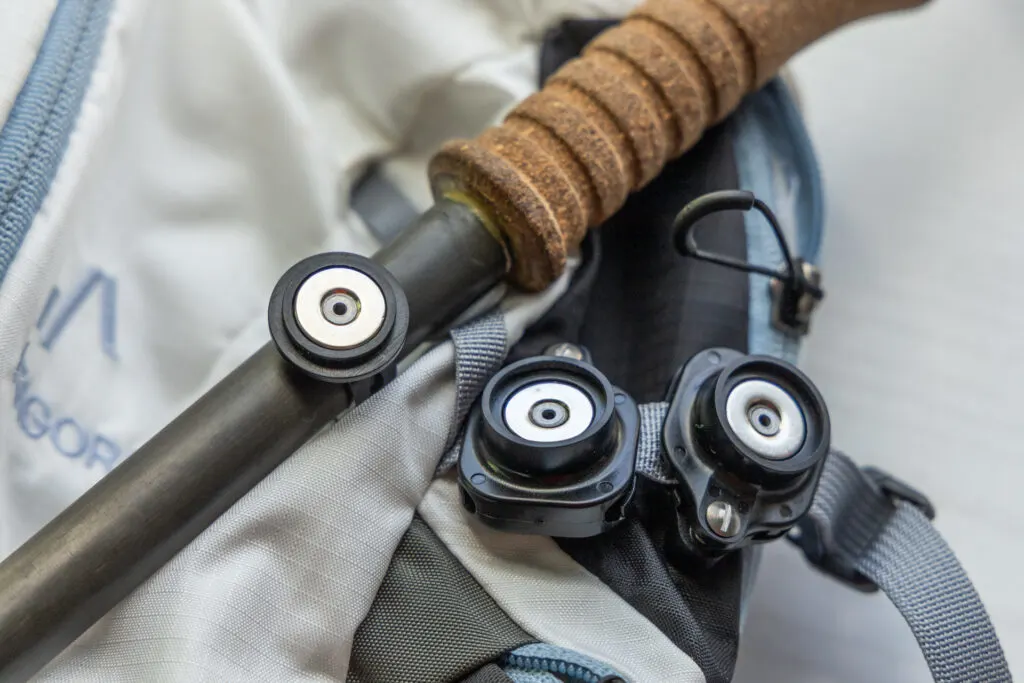
Spuds Stick Stashers: You Decide
Weight: 1.7oz
Thanks to strong magnets, these Stick Stashers by Spuds Adventure Gear are backpack gadgets that allow you to quickly and easily, while you’re on the move, collapse your trekking poles and easily clip them to your pack. No taking off your pack to strap them onto the back, no bungees to wrestle with on your running vest-style shoulder straps, just a pair of magnetic clips: one that attaches to webbing on the side of your pack and one that clips to the shaft of your trekking pole. All you have to do is reach around and let the magnets do their thing and you can hike hands-free, then deploy your poles again with ease.
They’re not crazy heavy, but strong magnets also aren’t light, so extreme ultralighters may balk at the weight. But if you stash and re-deploy your trekking poles often, and if you are endlessly annoyed with the process (I often am), then the ability to attach a pole with the swing of an arm may be worth it. The only thing that gives me pause: unless you can also slide the bottom tips into some webbing, they do tend to swing on the side of your pack a fair bit. So more testing is required to decide if these are truly worth the weight or not. As is, these seem more personal preference than anything.
Alternative: Use bungees on your pack straps or add on some lightweight after-market pack bungees to your straps so sticks are easy to attach on the go.
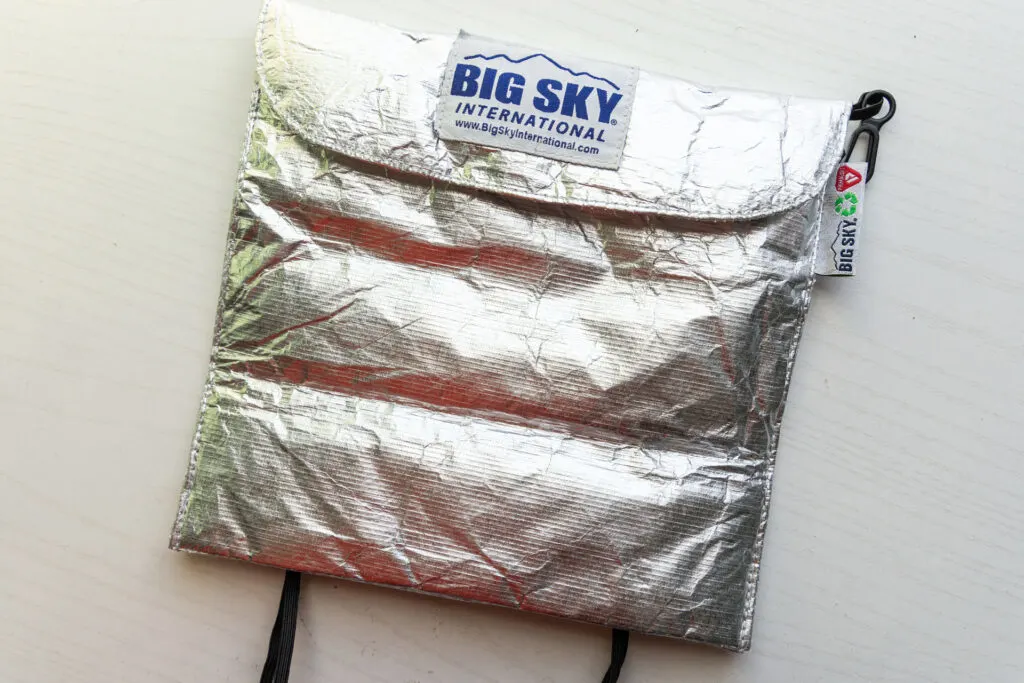
Big Sky Insulated Food Pouch: Waste of Space
Weight: 1oz/28g
If you’re worried about your dehydrated meals getting cold while they rehydrate, enter the Insulated Food Pouch from Big Sky International. No matter how cold it is outside, just add hot water to your bagged meal, stash the meal pouch inside this insulated envelope, and let it keep your dinner warm while you wait. That’s this ultralight gadget’s whole purpose.
But we’ve said it before and we’ll say it again: an insulated food pouch is not a necessary piece of gear. We’ve never carried one and probably never will. It’s extra weight and bulk (however little there is of both) for very little extra benefit. By which I mean, it doesn’t offer any value above and beyond gear you probably already have. This is a unitasker, and not a particularly useful one. For example, you could wrap up your backpacking meal in a spare shirt, pair of pants, or your camp towel. You could sit it inside your sleeping bag (just make sure it’s sealed up tight). Or do as we’ve always done: tuck it in your jacket while it rehydrates, which keeps both your meal AND you warm as it cooks. It’s always worked for us!
We tested the small version, which may be too snug for some meal packaging, but there is also a medium and large size available.
Alternative: Your jacket, towel, spare item of clothing.
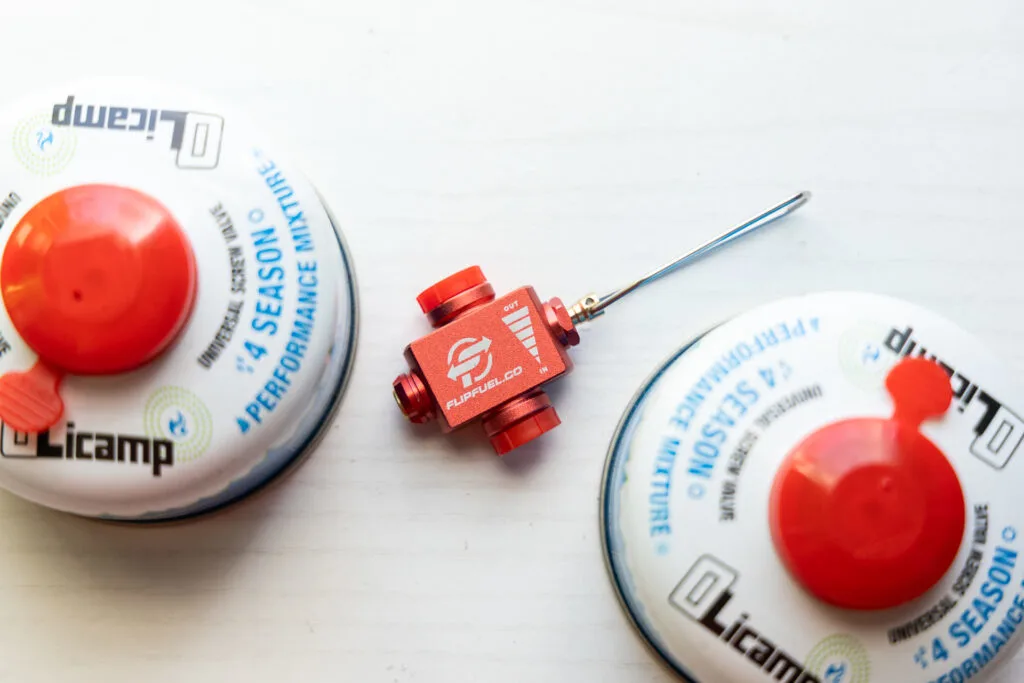
FlipFuel Fuel Transfer Device: Worth the Weight
Weight: 1.5oz
Of all the things on this list, this might be our favorite; a genuinely useful ultralight gadget that is supremely functional, but also has the ability to save you money and reduce fuel weight. It’s also a unitasker, but does an important job and does it well: it transfers IsoButane fuel from one half-empty backpacking fuel canister to another. And every backpacker who has a stack of 1/4 full canisters in a corner somewhere knows what a useful function that is. Because no one wants to pack multiple half-empty canisters or risk bringing one just to possibly run out of fuel and have to carry an empty container for days while you cold soak the rest of your meals.
This gadget solves that problem by offering a way to combine the fuel from multiple canisters into one, which means less waste, more savings, and fewer half used containers sitting around. Thru hikers will likely also find this a worthwhile weight investment simply so they can put all those mostly empty canisters in free hiker boxes to use refilling their own! Honestly, I can’t believe I didn’t buy one of these sooner. It’s perhaps the only item on this list that I would recommend to backpackers across the board without hesitation. It’s one of the best backpacking gadgets out there.
Alternative: Carry multiple half-used containers into the backcountry.

Jereko Gear Driver: You Decide
Weight: 16g
The Jereko Gear Driver is a 3D-printed piece of gear that fits over the top of your cathole shovel or tent stake to offer a larger, more comfortable surface on which to push down to either dig a cathole or insert tent pegs into hard soil. It’s meant to make doing either easier. And it does do just that to some degree. But we don’t personally think it does enough to make it worth the weight. That said, we’re able-bodied individuals; if you have arthritis or difficulty with hand strength or dexterity, you may have a very different opinion. Indeed, if that’s you, this could very well be not only a handy piece of gear, but a vital one, which is why we’re reticent to call it a waste of space.
We probably won’t be bringing it on our next backpacking trip, though. Besides being just another bauble to lose in the bottom of our packs, plenty of other tools can be used to help hammer things into the ground. We usually just use the bottom of our boot or find a rock to help pound stakes in if necessary or reposition our grip on our ultralight trowel.
Alternative: Use your hands and/or a rock.
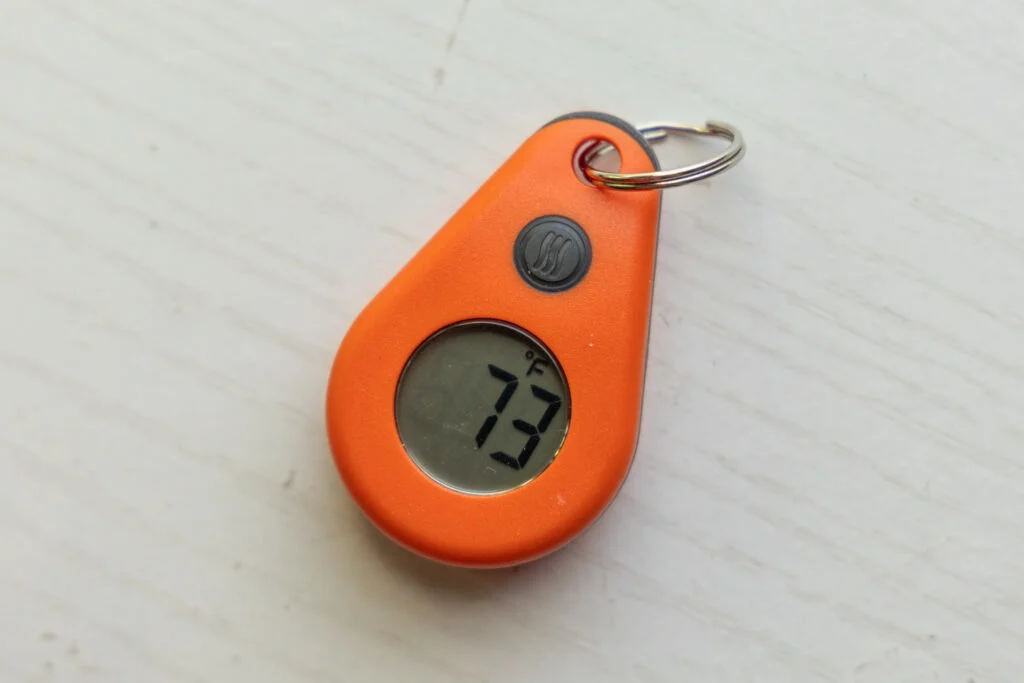
ThermoWorks ThermoDrop Thermometer: Waste of Space
Weight: 0.5oz/14.3 g
The ThermoDrop zipper pull thermometer is exactly what it sounds like and very little more: a digital ultralight thermometer you can clip onto a zipper pull that tells you the temperature in Fahrenheit or Celsius plus the low and high from the past 24 hours.
But here’s a controversial opinion: once you’re out in the wilderness, you really don’t need to know the temperature. There. I said it. Why? Because it’s too late to do anything about it. You should already have everything you need by the time you realize it’s cold. Or hot. Or whatever. Which makes this tool essentially just for data-obsessed hikers who feel the need to collect every bit of information from a hike they can. If that’s you, then go nuts! Get yourself a thermometer for your zipper. Otherwise, we think its practical usefulness is limited for most backpackers.
Alternative: Use your phone as a Thermodrop alternative. Or be OK with not knowing until you get home.
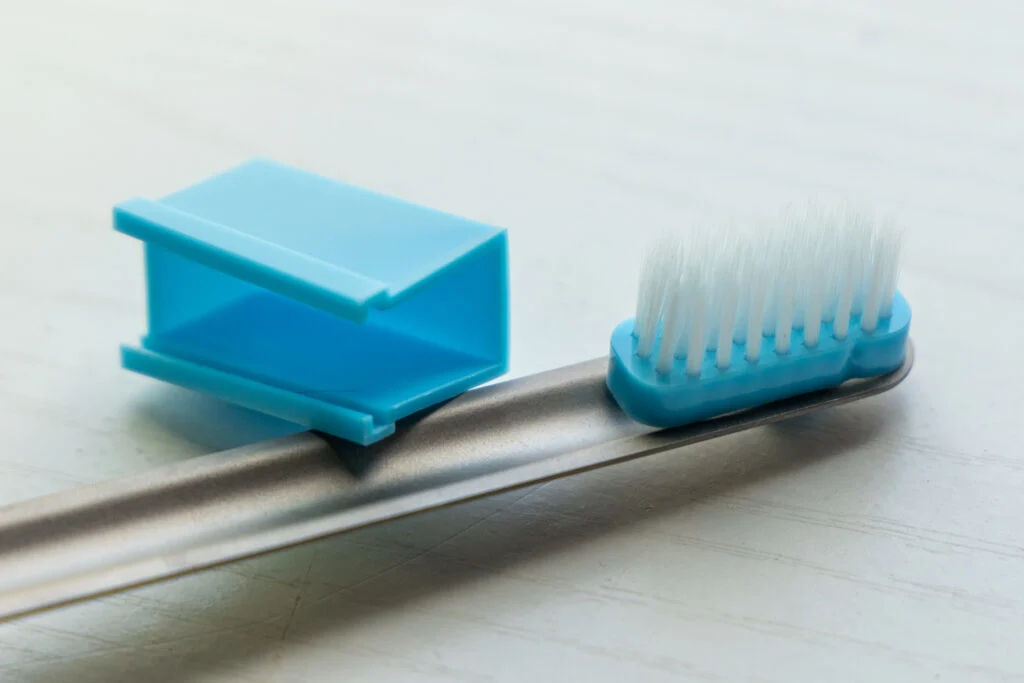
Trailbrush: Waste of Space
Weight: 4.4g
Why are ultralighters so obsessed with tiny toothbrushes? Sure, I’ve cut my fair share of toothbrushes in half. But I’m past that because it makes it really hard to brush your teeth. And mouth health is important. Also, when your toothbrush is that short, you’re probably sticking half your fingers in your mouth, too, and that’s the fastest way to get E.Coli on the trail.
Enter the Trailbrush, a tiny toothbrush head with a cover that pops onto the end of most sporks with clip holes at the end, effectively turning your spoon into a toothbrush handle. Seems cool! But now we’re back to the E.Coli argument: If your hands aren’t clean every time you use your spoon, and you haven’t just washed your spoon, you’re sticking the end of the utensil you touch the most in your mouth, then putting your hands all over the bowl of the spoon while you brush. Gross. But maybe that’s just me. Also, I hate the feeling of titanium in my mouth, so I absolutely will not be putting a metal spoon handle anywhere near my teeth and gums. Also important to note: we tried it on two different spoons and the Trailbrush either popped off after a few brushstrokes or didn’t fit snuggly in the hole in the spoon handle at all. UPDATE: It didn’t come with instructions so we didn’t realize you have to remove the small rubber ring from the Trailbrush, pop the head on the spoon, then reattach the ring on the back side of the spoon to hold it in place. Doesn’t matter. Even if it works we’re still going to pass.
Alternative: Just use a regular toothbrush. It adds a negligible amount of weight.

Igneous Gear Ultralight Repair Spool: Waste of Space
Weight: 0.49oz/14g
The Igneous Gear Ultralight Repair Spool is a small 3D-printed spool with duct tape wrapped around the bottom portion, nylon thread around the top, and a tiny compartment with a cap that contains a needle. All handy tools to make repairs to gear in the field. The problem (in our opinion)? You really don’t need a dedicated kit for any of that stuff and alternatives are lighter and possibly easier to use. Wrap duct tape or gaff tape around your trekking pole. Don’t use poles? Use an old credit card cut in half or small piece of cardboard. Do the same for thread and tuck a needle in there.
Also, when testing it at home, I almost lost the needle immediately just by opening the cap and tipping the needle out. If you dropped it on the ground outdoors, you would never find it again. This tool could be helpful for thru-hikers already on the trail who need tape and a needle and thread, like, now, and don’t have a place to stash the rest of a spool of thread or roll of tape, but for everyone else, DIYing will be lighter.
Alternative: Wrap tape around your trekking pole, water bottle or a slice of old credit card. Wrap a needle and thread around a small piece of cardboard.
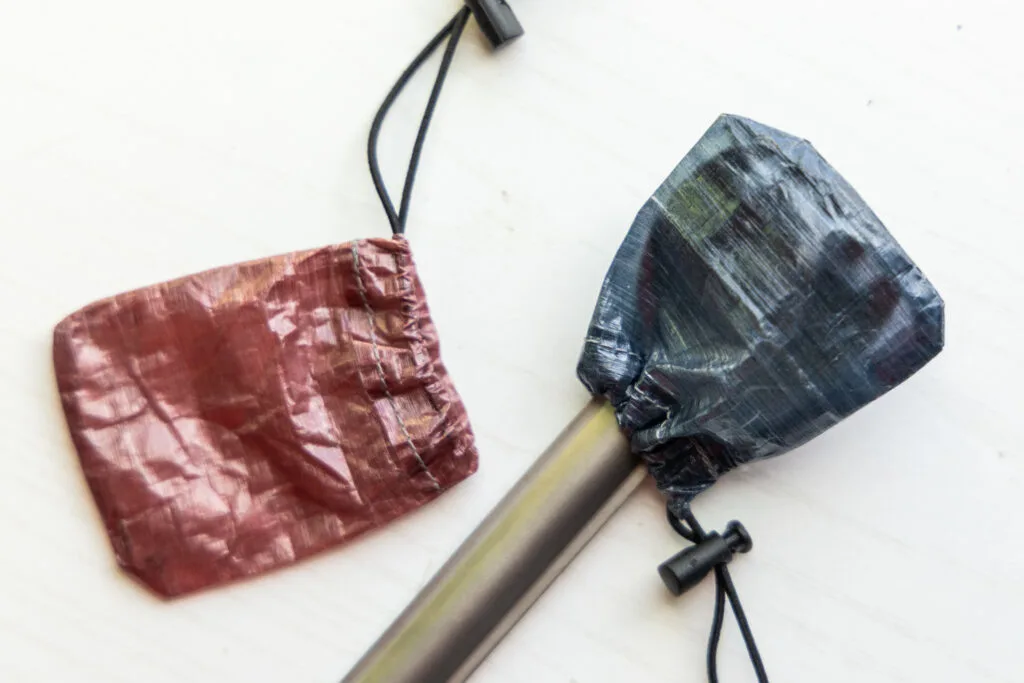
Aardwolf Mini Ditty Stuff Sacks: Worth the Weight
Weight: 1.2g
These Mini Ditty stuff sacks from Aardwolf Gear Company are as small and useful as they look. Perfectly tiny and truly ultralight, they work perfectly to contain small items like meds or spare change, but they may be best suited as spoon or toothbrush covers. Just pop one on the end of either to keep dirt, grime and more off the gear that goes in your mouth to keep them clean and ready to use. I hate dropping my spoon and toothbrush into stuff sacks with other gear or kitchen stuff because I know I’ll be putting those into my mouth later and really have no idea what’s floating around at the bottom of those sacks. Gross. So these absolutely are worth the (very minimal) weight in my book.
Yes, a simple plastic zip-top bag would do the same thing, but these are easier to clean, won’t puncture as easily, won’t need replaced regularly, and are just as light. Meaning they’re the more sustainable option.
Ultralight Alternative: Use a zip-top bag.

Suluk 46 Miksa Pot Lifter: Waste of Space
Weight: .18oz/4.9g
The Miksa Pot Lifter from Suluk 46 has one purpose: to lift pots onto and off of your backpacking stove. It works by opening up and then clamping down on the lip of ultralight pots. And it does so effectively (up to a certain weight). We were able to lift a pot with about 2+ cups of water in it without worrying too much about spilling. But not so much we would trade it for functional pot handles. Which is why we think–small and light as it is–it’s a waste of space.
For a few reasons: it’s so small we think we’ll end up spending more time than we’d like digging for it in the bottom of our stuff sack, we’ll probably lose it after setting on the ground nearby, and it’s not really more efficient than a small ultralight camp towel that can be used as a potholder when removing your pot from the stove. Also, forget using it with gloves on; It’s too dang small. So in the winter, it’s a no-go.
Ultralight Alternative: Just get a pot that has a built-in fold-up handles like one of these ultralight pots. Or use a multi-functional item like your camp towel to grab a hot pot off your backpacking stove.

Summit Suds/Pika Outdoors Backwoods Bidet: Waste of Space
Weight: 0.35oz/10g
If your least favorite thing about leaving home for a backpacking trip is leaving your bidet at home, then take heart: there are a number of portable ultralight bidets on the market. The Backwoods Bidet is one of them. The 3D-printed cap twists onto any standard plastic water bottle–including Smart Water bottles and reusable CNOC bottles–and turns them into your own personal bidet. Honestly, I thought I would love that. Turns out, not so much. That’s because in addition to having to put a water bottle near some very unsanitary areas, it doesn’t seem to work that well. It started to dribble water out the minute I turned the attached bottle upside down, then when I squeezed, the jet wasn’t all that powerful. Basically, there’s the potential for more to get wet than just your bum.
So we think unless you’re a die-hard bidet user, this one is a waste of space. If you want more than dry toilet paper for backcountry bathroom breaks, compressed wipes from Pact Outdoors will do a much better job. Just wet the tablet with a few drops of water, expand it to a 9×9 *actually* compostable wipe, then drop it in your cathole or pack it out when you’re done. The exception to this suggestion is thru hikers who may not be able to restock compressed wipes as easily and also don’t get to shower as often. Those folks may find a bidet more useful.
Alternative: Pact Outdoors compressed wipes.
Bottom Line: Ultralight Backpacking Gadgets
As you can see, most ultralight backpacking gadgets aren’t worth the weight or the space for most ultralight backpackers. In many cases, there are better options out there for gear that’s more functional as-is and doesn’t require you to purchase another “cool” backpacking gadget that’s just going to add weight to your pack. In other cases, they’re just completely unnecessary. The only ultralight gadgets that are going in our ultralight backpacks are ones that genuinely make the experience of backpacking better for not just us, but a large group of people.
Looking for more articles and videos about ultralight backpacking? Check out our favorite 5 Tips or the biggest mistakes beginner ultralighters make.

Henry
Sunday 30th of March 2025
The Thermodrop keeps you warmer and lighter on trips to come; if you get cold on a trip then you'll know what the temp was right where you were, instead of having to waste time looking up weather history and probably getting less accurate information. This allows you to know if the forecast was off, or you didn't bring enough gear, or maybe you brought MORE warmth than necessary. It gives you the info you need to make better gear choices in the future and that is 100% worth half an ounce (to me).
SalsaSandia
Wednesday 2nd of April 2025
@Henry, do you have MARSIS? If not just, you know, feel the air. Is it cold? Well there you go. Write it down or actually remember it. Needing to know the exact temp is control freak level weirdness and mother nature loves irony.
Alisha McDarris
Monday 31st of March 2025
Well there ya go! See, we knew somebody would find a way to make this piece of gear useful. I actually love to hear what we all find important/useful when we're outdoors and how priorities differ so much!